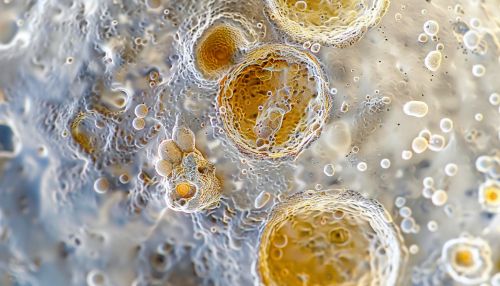Cell Aging
Introduction
Cell aging, also known as cellular senescence, is a complex biological process involving the gradual deterioration of cellular function over time. This process is influenced by a variety of factors, including genetic and environmental influences, and is a key factor in the overall aging process of an organism read more.


Mechanisms of Cell Aging
Cell aging is primarily driven by two main mechanisms: telomere shortening and oxidative stress.
Telomere Shortening
Telomeres are specialized structures located at the ends of chromosomes that protect the genetic material from degradation. Each time a cell divides, its telomeres shorten. When telomeres reach a critically short length, the cell enters a state of senescence and stops dividing, a phenomenon known as the Hayflick limit read more. This process is closely linked to the aging process and the onset of age-related diseases read more.
Oxidative Stress
Oxidative stress refers to the imbalance between the production of reactive oxygen species (ROS) and the ability of the cell to counteract their harmful effects through neutralization by antioxidants. High levels of ROS can cause damage to cellular components, including DNA, proteins, and lipids, leading to cell dysfunction and senescence read more.
Role of Cell Aging in Disease
Cell aging plays a significant role in the pathogenesis of various diseases, particularly age-related diseases such as cancer, cardiovascular disease, and neurodegenerative disorders.
Cancer
In cancer, cell aging acts as a double-edged sword. On one hand, cellular senescence is a potent tumor suppressor mechanism, as it prevents the proliferation of damaged cells that could potentially become cancerous. On the other hand, senescent cells can secrete a variety of factors that promote inflammation and tissue remodeling, which can contribute to tumor progression read more.
Cardiovascular Disease
In cardiovascular disease, cell aging contributes to the deterioration of the heart and blood vessels. Senescent cells in the heart can impair cardiac function, while senescent cells in the blood vessels can promote atherosclerosis, a condition characterized by the buildup of fatty deposits in the arteries read more.
Neurodegenerative Disorders
In neurodegenerative disorders, such as Alzheimer's disease and Parkinson's disease, cell aging can lead to the loss of neurons and cognitive decline. Senescent cells in the brain can secrete factors that promote inflammation and neuronal death, contributing to the progression of these disorders read more.
Therapeutic Strategies Targeting Cell Aging
Given the significant role of cell aging in disease, there is considerable interest in developing therapeutic strategies that target cellular senescence. These strategies can be broadly divided into two categories: senescence-inducing therapies and senescence-clearing therapies.
Senescence-Inducing Therapies
Senescence-inducing therapies aim to induce senescence in cancer cells, thereby preventing their proliferation. This approach has been successfully used in the treatment of certain types of cancer, such as leukemia and lymphoma read more.
Senescence-Clearing Therapies
Senescence-clearing therapies, also known as senolytics, aim to selectively eliminate senescent cells from tissues. This approach has shown promise in preclinical models of age-related diseases, and is currently being tested in clinical trials read more.
Conclusion
Cell aging is a complex biological process that plays a critical role in the aging process and the pathogenesis of various diseases. Understanding the mechanisms underlying cell aging and developing therapeutic strategies that target cellular senescence hold great promise for improving health and longevity.
